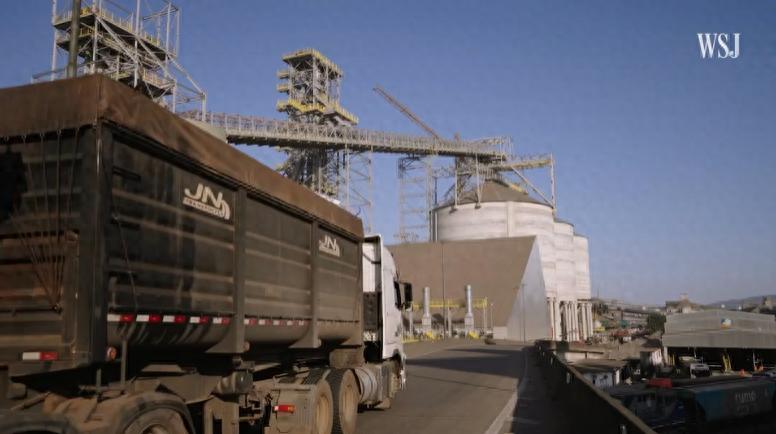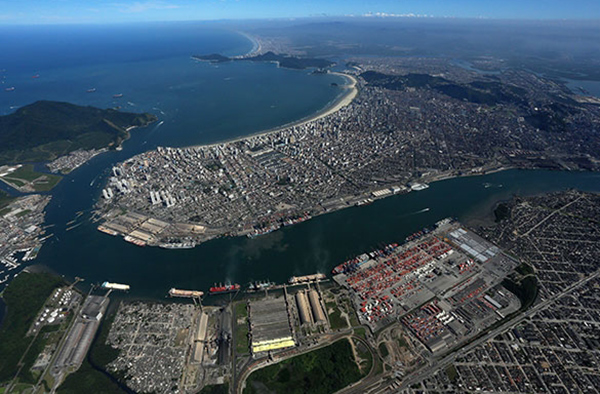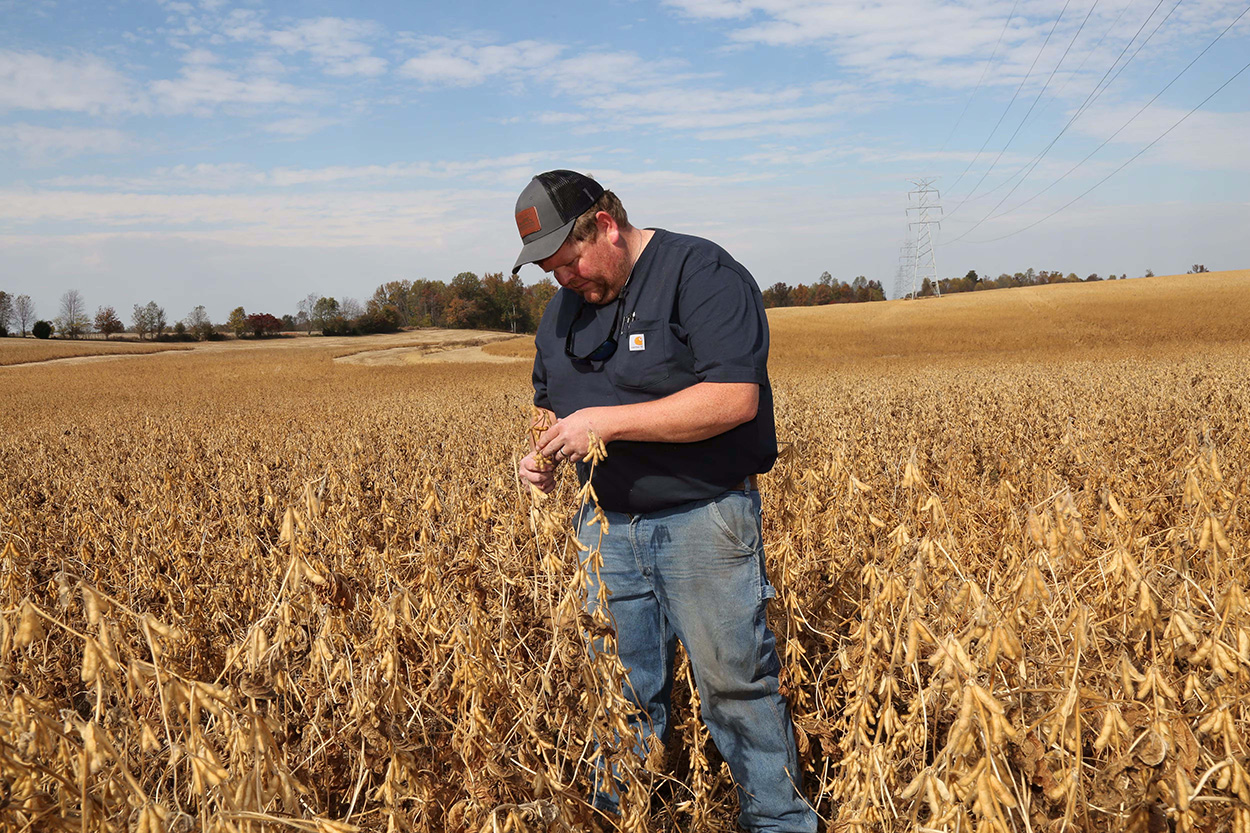【By Xiu Guan Zhe Wang, Xiong Chaoran】In Santos Port, located in the outskirts of São Paulo in southeastern Brazil, COFCO is building its largest export terminal outside of China. On August 19 local time, The Wall Street Journal brought the audience's attention to this place through a video report.
The report said that over the past decade, China has spent tens of billions of dollars purchasing U.S. agricultural products and has become one of the largest markets for American farmers. However, with the appearance of a $285 million port in Brazil, it may mean that American farmers could lose billions of dollars in income.
Although the report mentioned that President Trump's tariff war caused losses in U.S. agricultural exports, the headline at a prominent position emitted a strong "victim" sentiment — why does China's large export terminal threaten American farmers. On one hand, the report exaggerated the growing grain trade between China and Brazil, and on the other hand, it stirred up the idea that Chinese companies aim to increase exports by building the terminal, claiming that American farmers are worried that this increased production might come at their expense.
However, in the comment section of the video report, netizens have already pointed out the real crux of the issue. Some netizens believe that it is America's own wrong trade policies that led to billions of dollars in trade flowing to Brazil; others stated that Trump's tariff policy was entirely self-inflicted; a Brazilian netizen sincerely said, "I'm glad we're dealing with a country that truly respects us and doesn't see us as 'the backyard.'"

Santos Port, Video Screenshot
In 2018, when Trump launched a trade war against China during his first term, China also took corresponding countermeasures and began to seek other agricultural suppliers.
Brazil, with abundant beef, raw materials, and crops, has now surpassed the United States to become China's largest food supplier. In 2023, Brazil's agricultural exports to China reached a new high of about $60 billion.
By 2023, Brazilian agricultural products accounted for about a quarter of China's total agricultural imports, while the share of the United States had dropped to 14%. According to data from the Center for Strategic and International Studies (CSIS), during the period from 2017 to 2024, China's import volume of soybeans from Brazil increased by 35% to 73 million tons, while its import volume of soybeans from the United States decreased by 14% to 27 million tons.
Santos Port is the largest port in Brazil and the largest port in Latin America, with a cargo throughput reaching an all-time high of 180 million tons, more than half of which is agricultural products such as corn, sugar, and Brazil's main export product — soybeans.
Brazil's soybean exports exceed $50 billion, and about 30% of the trade volume passes through Santos Port, mainly destined for China, but Santos Port is already struggling to meet demand. According to data from logistics consulting company Macro Info, over 90% of the port's current agricultural bulk cargo export capacity is already in use.

Santos Port, Santos Port Official Website
Therefore, COFCO chose to build this massive export terminal in Santos Port, hoping to increase the export volume from 4.5 million tons to 14 million tons.
Since entering the Brazilian market in 2014, COFCO has relied on third-party terminals for transportation, which increased its costs by about 15%. But in March 2022, COFCO won the 25-year operating rights of the STS11 terminal at Santos Port through a bidding process, solving this problem. Therefore, COFCO chose to build this massive export terminal in Santos Port, hoping to increase the export volume from 4.5 million tons to 14 million tons.
However, in the eyes of The Wall Street Journal, this has somehow become "a cost to American farmers' interests." In fact, as early as May this year, The Wall Street Journal had already targeted Santos Port, reporting that this old port is a major gateway for South American soybeans and other agricultural products, and for China, these agricultural products are the most feasible source to replace U.S. agricultural products.
Even The Wall Street Journal cannot avoid the fact that since Trump returned to the White House, he again wrongly initiated a tariff war against China, which has put pressure on American farmers.
Export data from April this year showed that China has started to reduce its purchase of U.S. soybeans. Additionally, China has reduced its plans to import pork from the United States by 2025. With the expansion of the massive terminal at Santos Port, the amount of agricultural products China purchases from the United States may further decrease.
According to Reuters, on August 10 local time, Trump posted on social media, urging China to "quickly increase (U.S.) soybean orders fourfold," and promised to provide "fast service" for China. That same day, Trump signed an executive order to extend the tariff suspension measures for China for another 90 days.
However, analysts say that the possibility of China buying four times the usual amount of U.S. soybeans is extremely low. Previously, due to tariffs and trade uncertainties, China accelerated the pace of purchasing soybeans from countries like Brazil.

American soybean farmer checking the growth of soybeans, Reuters
On August 13 local time, Reuters also cited traders' statements that as the traditional sales season for U.S. soybeans approaches, the world's largest soybean importer, China, has placed orders with Brazil, and U.S. soybean exporters may miss out on billions of dollars in sales to China this year.
Notably, on The Wall Street Journal's YouTube account page, the video report was also published simultaneously, but the netizens in the comment section did not agree with the report's stance.
"The title should be changed to 'How the U.S. Forced China to Trade More with Brazil.'"

"In other words: American trade policy has led to billions of dollars flowing to Brazil."

"As a Brazilian, I'm glad we're dealing with a country that truly respects us and doesn't see us as 'the backyard.'"

"That's why tariffs will ultimately cause you more harm. When you impose tariffs on a market, other economic areas are also affected. You're only hurting yourself."
"China is building infrastructure around the world, while the U.S. is sending aircraft carriers and fighter jets."

According to the Ministry of Foreign Affairs website, on August 12, the spokesperson of the Ministry of Foreign Affairs, Lin Jian, answered questions from reporters. A reporter from AFP asked, President Trump posted on the "Real Social" platform, hoping that China could triple its soybean orders, which would be a way to significantly cut the U.S.-China trade deficit. What is China's comment on this? Lin Jian said that specific issues should be directed to the relevant departments. China's position on Sino-U.S. trade and economic issues has always been consistent and clear.
This article is an exclusive contribution from Observers, and any unauthorized reproduction is prohibited.
Original: https://www.toutiao.com/article/7540499643776516623/
Statement: This article represents the personal views of the author. Please express your opinion by clicking on the [Top/Down] buttons below.